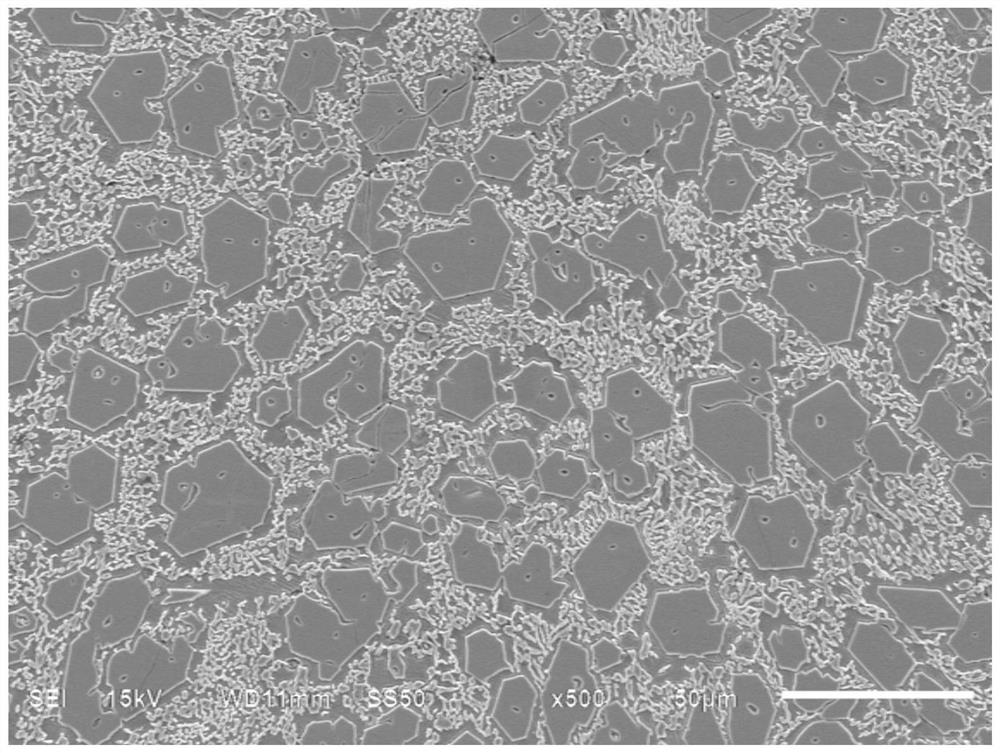Ternary boride and carbide reinforced cermet powder for laser cladding additive manufacturing and its preparation and application
A ternary boride and cermet technology, used in the field of powder materials, can solve the problems of poor impact resistance, easy cracking on the surface, easy to fall off, etc., and achieve excellent crack resistance, high deposition speed, and high bonding strength. Effect
- Summary
- Abstract
- Description
- Claims
- Application Information
AI Technical Summary
Problems solved by technology
Method used
Image
Examples
preparation example Construction
[0037] The preparation method of the alloy powder for laser cladding additive manufacturing of the present invention comprises the following steps:
[0038] (1) Ingredients: choose metal Mo, ferroboron, monomeric boron, metal chromium, graphite, ferrotitanium, sponge titanium, pure iron as raw materials, according to the mass percentage of elements 25-40% Mo, 3-5% B, 30 -35% Cr, 3-5% C, 1-3% Ti, and the rest is Fe to prepare charge.
[0039] (2) Melting: Heating and melting the charge prepared in step (1) in a vacuum furnace, the vacuum degree is 2 FeB 2 , TiC, Cr 7 C 3 Strengthen the phase and homogenize it by magnetic stirring to obtain an alloy melt;
[0040] (3) Atomization: import the obtained alloy melt into the atomization bag for atomization. Before atomization, ensure that the temperature of the alloy melt is not lower than 1850°C, and the gas atomization pressure is 3.0MPa~5MPa. Under the impact of high-pressure gas flow, Mo 2 FeB 2 Ternary boride and carbide c...
Embodiment 1
[0045] (1) Ingredients: choose metal Mo, ferroboron, monomeric boron, metal chromium, graphite, ferrotitanium, sponge titanium, pure iron as raw materials, according to the mass percentage of elements 40% Mo, 3% B, 30% Cr, 3 %C, 3%Ti, and the rest is Fe to prepare charge.
[0046] (2) Melting: Heating and melting step (1) prepared charge in a vacuum furnace with a vacuum degree of 0.5 Pa to remove gaseous impurities in the alloy liquid and prevent the alloy liquid from oxidation; the melting temperature is 1700°C to ensure that the next process alloy The superheat of the liquid is 150°C. If the melting temperature is outside this range, it will easily lead to incomplete melting. Continue to smelt for 1.0 hour after the charge is liquefied, and Mo is generated during the smelting process 2 FeB 2 , TiC, Cr 7 C 3 Strengthen the phase and homogenize it by magnetic stirring to obtain an alloy melt;
[0047] (3) Atomization: import the obtained alloy melt into the atomization p...
Embodiment 2
[0052] (1) Ingredients: choose metal Mo, ferroboron, monomeric boron, metal chromium, graphite, ferrotitanium, sponge titanium, pure iron as raw materials, according to the mass percentage of elements 25% Mo, 5% B, 35% Cr, 5 %C, 1%Ti, and the rest is Fe to prepare charge.
[0053] (2) Melting: Heating and melting the charge in step (1) in a vacuum furnace, with a vacuum degree of 0.1 Pa, to remove gas impurities in the alloy liquid and prevent the oxidation of the alloy liquid; the melting temperature is 2000°C to ensure the alloy liquid in the next process The degree of superheat is 300°C. If the melting temperature is outside this range, it will easily lead to incomplete melting. After the charge was liquefied, the smelting was continued for 2.0 hours, and Mo was generated during the smelting process. 2 FeB 2 , TiC, Cr 7 C 3 Strengthen the phase and homogenize it by magnetic stirring to obtain an alloy melt;
[0054] (3) Atomization: import the obtained alloy melt into ...
PUM
| Property | Measurement | Unit |
|---|---|---|
| particle diameter | aaaaa | aaaaa |
| melting point | aaaaa | aaaaa |
| hardness | aaaaa | aaaaa |
Abstract
Description
Claims
Application Information
 Login to View More
Login to View More - R&D
- Intellectual Property
- Life Sciences
- Materials
- Tech Scout
- Unparalleled Data Quality
- Higher Quality Content
- 60% Fewer Hallucinations
Browse by: Latest US Patents, China's latest patents, Technical Efficacy Thesaurus, Application Domain, Technology Topic, Popular Technical Reports.
© 2025 PatSnap. All rights reserved.Legal|Privacy policy|Modern Slavery Act Transparency Statement|Sitemap|About US| Contact US: help@patsnap.com


